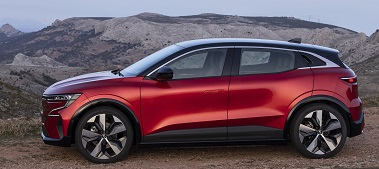Key specs
Renault Megane E-Tech Electric (SUV) Megane E-Tech Electric 2021,2022,2023,2024,2025,2026
What is the body type, Renault Megane E-Tech Electric EV40 40 kWh (130 Hp) 2021?
SUV, 5 Doors, 5 Seats
How fast is the car, Renault Megane E-Tech Electric EV40 40 kWh (130 Hp) 2021?
160 km/h 99.42 mph
How many cylinders, Renault Megane E-Tech Electric EV40 40 kWh (130 Hp) 2021?
Electric,
What is the drivetrain, Renault Megane E-Tech Electric EV40 40 kWh (130 Hp) 2021?
Front wheel drive,
How long is this vehicle, Renault Megane E-Tech Electric EV40 40 kWh (130 Hp) 2021?
4210 mm
165.75 in.
How wide is the vehicle, Renault Megane E-Tech Electric EV40 40 kWh (130 Hp) 2021?
1780 mm
70.08 in.
What is the curb weight, Renault Megane E-Tech Electric EV40 40 kWh (130 Hp) 2021?
1513 kg
Standard Charge
Renault Megane E-Tech Electric (SUV) Megane E-Tech Electric 2021,2022,2023,2024,2025,2026 Specs
General information
| Brand |
Renault |
| Model |
Megane E-Tech Electric (SUV) |
| Version |
Megane E-Tech Electric |
| Engine version |
EV40 40 kWh (130 Hp) |
| Year production start |
2021 |
| Vehicle type |
SUV |
| Overall length mm - inch |
4210 mm
165.75 in.
|
| Doors |
5 |
| Top Speed |
160 km/h 99.42 mph |
Engine specs
| Engine position and orientation |
Front, Transverse |
| Cylinders |
Electric |
| Fuel type |
Electricity |
| Powertrain architecture |
BEV (Electric Vehicle) |
| Electric motor power |
130 Hp
|
| Electric motor torque |
250 Nm 184.39 lb.-ft.
|
| Engine location |
Front, Transverse
|
| Total available power |
130 Hp
|
| Eng 56 |
electrically excited synchronous motor (EESM)
|
| Eng 57 |
Battery Lithium-ion 400 V
|
| Eng 59 |
Standard Charge with 22 kW 32A from 0% to 100% 6h17min
|
Transmission and Drive system
| Drive configuration |
Front wheel drive
|
Brakes
| Front brakes |
Ventilated discs 320/28 |
| Rear brakes |
Ventilated discs 292/16 |
| Anti-lock brake system |
ABS (Anti-lock braking system) |
Steering
| Steering type |
Steering rack and pinion |
| Turns (lock-to-lock) |
2.3 |
| Turning diameter m - ft |
10.4 m
|
Suspension
| Front suspension |
Pseudo McPherson |
| Rear suspension |
Multi-link |
Wheels & Tyres
| Wheels size |
195/60 R18 or 215/55 R20
|
Passenger
| Passengers seats |
5 |
| Trunk space min liter | cu. Ft. |
440 l
15.54 cu. ft.
|
Dimensions
| Overall length mm - inch |
4210 mm
165.75 in.
|
| Overall width mm -inch |
1780 mm
70.08 in.
|
| Overall height mm -inch |
1500 mm
59.06 in.
|
| Wheelbase mm - inch |
2700 mm
106.3 in.
|
| Track width front mm - inch |
1548 mm
|
| Track width rear mm - inch |
1530 mm
|
Weights
| Curb weight kg -lbs total |
1513 kg
Standard Charge
|
| Gross weight kg -lbs total |
2017 kg
Standard Charge
|
Fuel economy
| Combined fuel consumption (WLTP) |
15.8 kWh/100 km |
| Fuel economy-190 |
300 km WLTP |
Engine type
Electric
https://www.thecarspec.com/components/engine/electric

